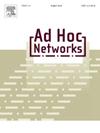Energy efficient clustering and routing for wireless sensor networks by applying a spider wasp optimizer
IF 4.4
3区 计算机科学
Q1 COMPUTER SCIENCE, INFORMATION SYSTEMS
引用次数: 0
Abstract
In wireless sensor networks, the network lifespan is a key factor in evaluating the effectiveness of a routing protocol. Most traditional routing protocols optimize cluster head election and intercluster routing as separate phases, which limits improvements in intercluster routing optimization. To address this issue, we propose a multi-hop routing protocol based on the Spider Wasp Optimizer (SWO) algorithm. This protocol integrates cluster head election and intercluster routing in the cluster head selection phase, using the SWO algorithm for optimization. Many multi-hop routing protocols select the shortest total path for data transmission between clusters. However, this approach can result in the distance between two cluster heads exceeding a predefined threshold, leading to increased energy consumption during transmission. To mitigate this, we introduce a communication distance factor in the objective function for optimization, employing intermediate relay points to avoid long-distance transmissions. Specifically, we propose a central relay point strategy to minimize forwarding energy consumption. To address the issue of forwarding load optimization, we utilize K-means clustering to group cluster heads and combine this with equidistant relay points and the Dijkstra algorithm to identify the optimal multi-hop paths between clusters, thereby extending the network’s lifespan. The proposed routing algorithm is implemented in MATLAB and compared with the PSO-C, EECHS-ISSADE, HBACS, and SSA-FND protocols. In the simulated scenarios, the network lifespan was improved by up to 32.7%, 27.5%, 18.2%, and 9.2%, respectively.

应用黄蜂优化器实现无线传感器网络的节能聚类和路由
在无线传感器网络中,网络寿命是评估路由协议有效性的关键因素。大多数传统路由协议将簇头选举和簇间路由作为单独的阶段进行优化,这限制了簇间路由优化的改进。为了解决这个问题,我们提出了一种基于蜘蛛黄蜂优化器(SWO)算法的多跳路由协议。该协议在簇头选择阶段集成了簇头选举和簇间路由,采用SWO算法进行优化。许多多跳路由协议选择在集群之间传输数据的最短总路径。然而,这种方法可能导致两个簇头之间的距离超过预定义的阈值,从而导致传输过程中的能量消耗增加。为了缓解这种情况,我们在优化目标函数中引入了通信距离因素,采用中间中继点来避免长距离传输。具体而言,我们提出了一个中心中继点策略,以最大限度地减少转发能耗。为了解决转发负载优化问题,我们利用K-means聚类对簇头进行分组,并将其与等距离中继点和Dijkstra算法相结合,以确定簇之间的最佳多跳路径,从而延长网络的寿命。在MATLAB中实现了该算法,并与PSO-C、EECHS-ISSADE、HBACS和SSA-FND协议进行了比较。在模拟场景中,网络寿命分别提高了32.7%、27.5%、18.2%和9.2%。
本文章由计算机程序翻译,如有差异,请以英文原文为准。
求助全文
约1分钟内获得全文
求助全文
来源期刊

Ad Hoc Networks
工程技术-电信学
CiteScore
10.20
自引率
4.20%
发文量
131
审稿时长
4.8 months
期刊介绍:
The Ad Hoc Networks is an international and archival journal providing a publication vehicle for complete coverage of all topics of interest to those involved in ad hoc and sensor networking areas. The Ad Hoc Networks considers original, high quality and unpublished contributions addressing all aspects of ad hoc and sensor networks. Specific areas of interest include, but are not limited to:
Mobile and Wireless Ad Hoc Networks
Sensor Networks
Wireless Local and Personal Area Networks
Home Networks
Ad Hoc Networks of Autonomous Intelligent Systems
Novel Architectures for Ad Hoc and Sensor Networks
Self-organizing Network Architectures and Protocols
Transport Layer Protocols
Routing protocols (unicast, multicast, geocast, etc.)
Media Access Control Techniques
Error Control Schemes
Power-Aware, Low-Power and Energy-Efficient Designs
Synchronization and Scheduling Issues
Mobility Management
Mobility-Tolerant Communication Protocols
Location Tracking and Location-based Services
Resource and Information Management
Security and Fault-Tolerance Issues
Hardware and Software Platforms, Systems, and Testbeds
Experimental and Prototype Results
Quality-of-Service Issues
Cross-Layer Interactions
Scalability Issues
Performance Analysis and Simulation of Protocols.
 求助内容:
求助内容: 应助结果提醒方式:
应助结果提醒方式:


